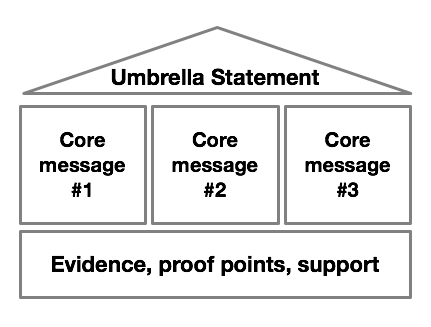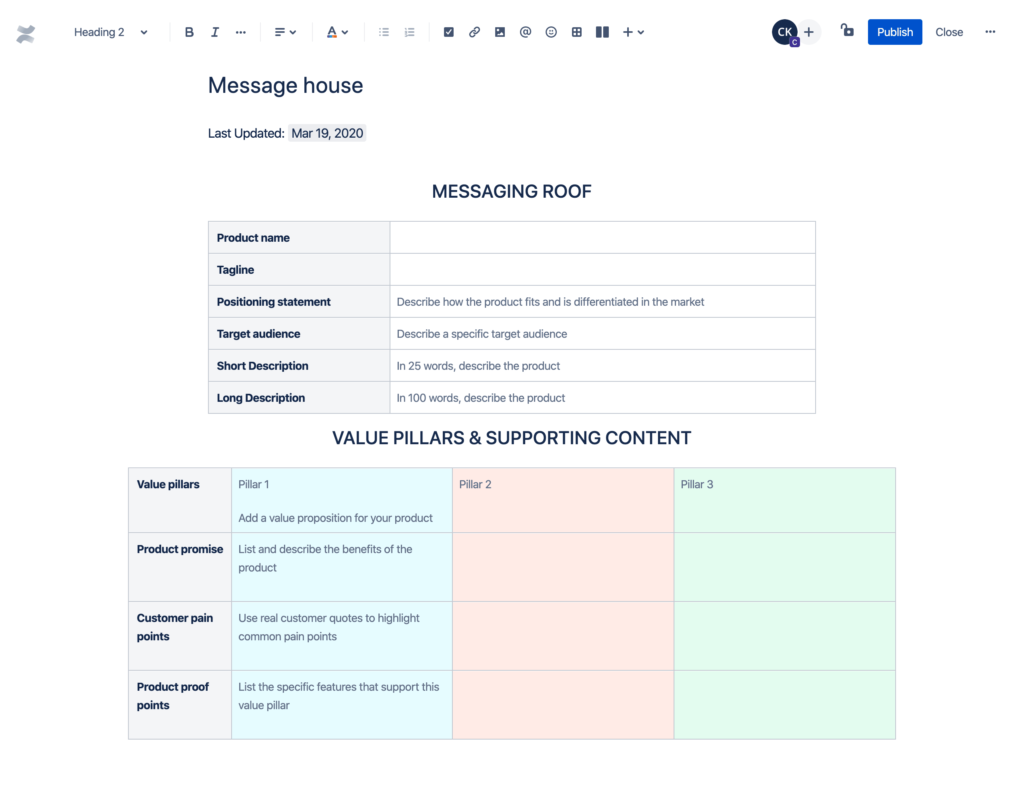When I was first introduced to the concept of the message house as a product manager, I saw some value in it, but I found it way too abstract to be useful. Perhaps that’s because I was shown message house templates that look like the following:

There wasn’t any guidance attached as to when to develop these, what level of resolution they should be at, and more importantly, after the messaging is completed, who should use the completed artifact, when, and for what activities. Unfortunately, many frameworks used in marketing seem to be academic exercises with little applicability to real-world activities. Even if “plans are worthless, but planning is everything”, shouldn’t the plans that are developed count for something, even directionally?
In the years since I first learned about the message house (sometimes just called a messaging document) – and then applied it to my work in product marketing – I’ve developed some opinions on how to best use this tool, as well as developed a few versions of messaging templates that I like. For starters, there are three levels of altitude at which message houses are useful:
- At the corporate marketing level, representing a company’s overall brand, voice, and differentiation – which often includes product positioning as a differentiator, but not entirely;
- At the product [product marketing] level, ensuring that there is a way to express a product’s values and benefits rather than just its features;
- For launches, where it’s necessary to convey the key messages and value delivered by the launch and tie it to both the company and product line positioning.
You’ll notice that the first two scenarios employ the message house as an evergreen artifact, whereas the last is more temporal. Each scenario also calls for the addition or elimination of certain fields (e.g., brand tone and voice are not important to specify in a product-level message house).
A Message House Template I Like
Because I tend to work more at the product level, I rely on a form of the message house that looks like this. This one comes from Atlassian, and of course you can use their template within Confluence, but it’s just as easy to make one in Microsoft Word or Google Docs or anything like that.

If you are a startup, this is the type of message house that I recommend you start with. You’re not yet a big enough corporation where your product marketing is substantially different than your corporate marketing – certainly not until you’ve established yourself to a point where your brand stands for something different than your product.
How to Fill it Out
Contrary to how most of us fill in forms, I recommend you do not start at the top. As a product manager or product marketer, it’s easier to start in the value pillars & supporting content section and work your way back up to the messaging roof after you’ve taken a couple swings at the value and benefit statements. If you are really struggling with this section, particularly if you are a technical founder, it’s ok to start at the very bottom of the value pillars section (product features) and work your way up. The value (no pun intended) of conducting this whole exercise is to get you away from speeds & feeds and towards value statements of how you will improve the life of the person who will pay you for your product. Features and capabilities of your product support those outcomes, but you shouldn’t lead with them in marketing.
Don’t worry about wordsmithing too much initially. The important thing is to write down your beliefs and to debate & test them with your team. Wordsmithing can come later, especially in the messaging roof section.
Finally, there are only three pillars for a reason. The marketing rule of three is an intentional constraint, forcing you to focus on only the top value drivers for your product or company. If you find yourself trying to cram in four pillars, take another swing at it until you can get down to three.
How to Use it Day-to-Day
Once you have developed the message house and gotten alignment with your team and other stakeholders on it, the litmus test of whether it’s right is whether and how you use it day-to-day. (Less applicable for launch-based message houses.)
You should use the message house with several constituents:
- Marketing, in particular demand generation and content marketing, so they know how to create campaigns and content that are on-message and highlight the most powerful value propositions and features of the product;
- Sales, in two ways. When selling to practitioners (you have a bottoms-up sales motion), use the message house from the bottom up also and work towards value. For example, when writing outreach sequences to these individuals, hit them with the most powerful and differentiated feature and then explain how it helps them save time, money, reduce risk, etc. When selling to buyers or decision-makers (you are using a top-down sales motion), start at the top by articulating value and then using customer proof points and one or two supporting features to back up those value statements;
- Engineering and design counterparts. It may seem counterintuitive to share artifacts like this with engineering and design, but I find that the more these folks know about the go-to-market and product positioning, the more empathetic they are towards customers. Plus, many engineers believe that marketing is a bunch of bullshit and fluff, and message houses are tool that you can use to explain that no, there’s an art and a science to it. Take their feedback, too. If they think that other product capabilities are better at backing up a value proposition – or if they believe that one of the pillars can be supplanted with a stronger one – take them seriously and consider it.
Best of luck with your marketing and using clear, concise messaging to win customers!